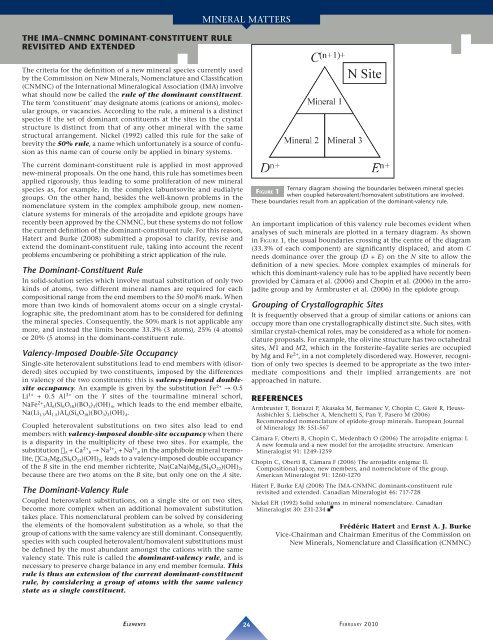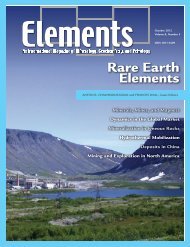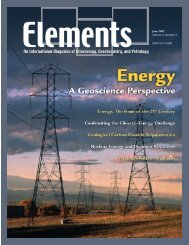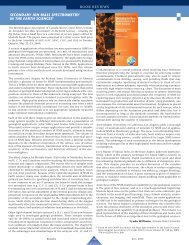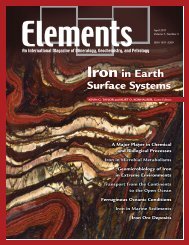Front Matter (PDF) - Elements
Front Matter (PDF) - Elements
Front Matter (PDF) - Elements
Create successful ePaper yourself
Turn your PDF publications into a flip-book with our unique Google optimized e-Paper software.
THE IMA–CNMNC DOMINANT-CONSTITUENT RULE<br />
REVISITED AND EXTENDED<br />
MINERAL MATTERS<br />
The criteria for the definition of a new mineral species currently used<br />
by the Commission on New Minerals, Nomenclature and Classification<br />
(CNMNC) of the International Mineralogical Association (IMA) involve<br />
what should now be called the rule of the dominant constituent.<br />
The term ‘constituent’ may designate atoms (cations or anions), molecular<br />
groups, or vacancies. According to the rule, a mineral is a distinct<br />
species if the set of dominant constituents at the sites in the crystal<br />
structure is distinct from that of any other mineral with the same<br />
structural arrangement. Nickel (1992) called this rule for the sake of<br />
brevity the 50% rule, a name which unfortunately is a source of confusion<br />
as this name can of course only be applied in binary systems.<br />
The current dominant-constituent rule is applied in most approved<br />
new-mineral proposals. On the one hand, this rule has sometimes been<br />
applied rigorously, thus leading to some proliferation of new mineral<br />
species as, for example, in the complex labuntsovite and eudialyte<br />
groups. On the other hand, besides the well-known problems in the<br />
nomenclature system in the complex amphibole group, new nomenclature<br />
systems for minerals of the arrojadite and epidote groups have<br />
recently been approved by the CNMNC, but these systems do not follow<br />
the current definition of the dominant-constituent rule. For this reason,<br />
Hatert and Burke (2008) submitted a proposal to clarify, revise and<br />
extend the dominant-constituent rule, taking into account the recent<br />
problems encumbering or prohibiting a strict application of the rule.<br />
The Dominant-Constituent Rule<br />
In solid-solution series which involve mutual substitution of only two<br />
kinds of atoms, two different mineral names are required for each<br />
compositional range from the end members to the 50 mol% mark. When<br />
more than two kinds of homovalent atoms occur on a single crystallographic<br />
site, the predominant atom has to be considered for defining<br />
the mineral species. Consequently, the 50% mark is not applicable any<br />
more, and instead the limits become 33.3% (3 atoms), 25% (4 atoms)<br />
or 20% (5 atoms) in the dominant-constituent rule.<br />
Valency-Imposed Double-Site Occupancy<br />
Single-site heterovalent substitutions lead to end members with (disordered)<br />
sites occupied by two constituents, imposed by the differences<br />
in valency of the two constituents: this is valency-imposed doublesite<br />
occupancy. An example is given by the substitution Fe 2+ → 0.5<br />
Li 1+ + 0.5 Al 3+ on the Y sites of the tourmaline mineral schorl,<br />
NaFe 2+ 3Al 6 (Si 6 O 18 )(BO 3 ) 3 (OH) 4 , which leads to the end member elbaite,<br />
Na(Li 1.5 Al 1.5 )Al 6 (Si 6 O 18 )(BO 3 ) 3 (OH) 4 .<br />
Coupled heterovalent substitutions on two sites also lead to end<br />
members with valency-imposed double-site occupancy when there<br />
is a disparity in the multiplicity of these two sites. For example, the<br />
substitution A + Ca 2+ B → Na 1+ A + Na 1+ B in the amphibole mineral tremolite,<br />
Ca 2 Mg 5 (Si 8 O 22 )(OH) 2 , leads to a valency-imposed double occupancy<br />
of the B site in the end member richterite, Na(CaNa)Mg 5 (Si 8 O 22 )(OH) 2 ,<br />
because there are two atoms on the B site, but only one on the A site.<br />
The Dominant-Valency Rule<br />
Coupled heterovalent substitutions, on a single site or on two sites,<br />
become more complex when an additional homovalent substitution<br />
takes place. This nomenclatural problem can be solved by considering<br />
the elements of the homovalent substitution as a whole, so that the<br />
group of cations with the same valency are still dominant. Consequently,<br />
species with such coupled heterovalent/homovalent substitutions must<br />
be defined by the most abundant amongst the cations with the same<br />
valency state. This rule is called the dominant-valency rule, and is<br />
necessary to preserve charge balance in any end member formula. This<br />
rule is thus an extension of the current dominant-constituent<br />
rule, by considering a group of atoms with the same valency<br />
state as a single constituent.<br />
Ternary diagram showing the boundaries between mineral species<br />
FIGURE 1<br />
when coupled heterovalent/homovalent substitutions are involved.<br />
These boundaries result from an application of the dominant-valency rule.<br />
An important implication of this valency rule becomes evident when<br />
analyses of such minerals are plotted in a ternary diagram. As shown<br />
in FIGURE 1, the usual boundaries crossing at the centre of the diagram<br />
(33.3% of each component) are significantly displaced, and atom C<br />
needs dominance over the group (D + E) on the N site to allow the<br />
definition of a new species. More complex examples of minerals for<br />
which this dominant-valency rule has to be applied have recently been<br />
provided by Cámara et al. (2006) and Chopin et al. (2006) in the arrojadite<br />
group and by Armbruster et al. (2006) in the epidote group.<br />
Grouping of Crystallographic Sites<br />
It is frequently observed that a group of similar cations or anions can<br />
occupy more than one crystallographically distinct site. Such sites, with<br />
similar crystal-chemical roles, may be considered as a whole for nomenclature<br />
proposals. For example, the olivine structure has two octahedral<br />
sites, M1 and M2, which in the forsterite–fayalite series are occupied<br />
by Mg and Fe 2+ , in a not completely disordered way. However, recognition<br />
of only two species is deemed to be appropriate as the two intermediate<br />
compositions and their implied arrangements are not<br />
approached in nature.<br />
REFERENCES<br />
Armbruster T, Bonazzi P, Akasaka M, Bermanec V, Chopin C, Gieré R, Heuss-<br />
Assbichler S, Liebscher A, Menchetti S, Pan Y, Pasero M (2006)<br />
Recommended nomenclature of epidote-group minerals. European Journal<br />
of Mineralogy 18: 551-567<br />
Cámara F, Oberti R, Chopin C, Medenbach O (2006) The arrojadite enigma: I.<br />
A new formula and a new model for the arrojadite structure. American<br />
Mineralogist 91: 1249-1259<br />
Chopin C, Oberti R, Cámara F (2006) The arrojadite enigma: II.<br />
Compositional space, new members, and nomenclature of the group.<br />
American Mineralogist 91: 1260-1270<br />
Hatert F, Burke EAJ (2008) The IMA-CNMNC dominant-constituent rule<br />
revisited and extended. Canadian Mineralogist 46: 717-728<br />
Nickel EH (1992) Solid solutions in mineral nomenclature. Canadian<br />
Mineralogist 30: 231-234<br />
Frédéric Hatert and Ernst A. J. Burke<br />
Vice-Chairman and Chairman Emeritus of the Commission on<br />
New Minerals, Nomenclature and Classification (CNMNC)<br />
ELEMENTS 24<br />
FEBRUARY 2010


